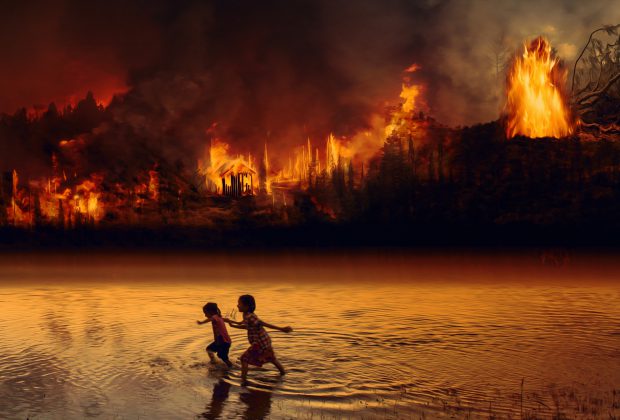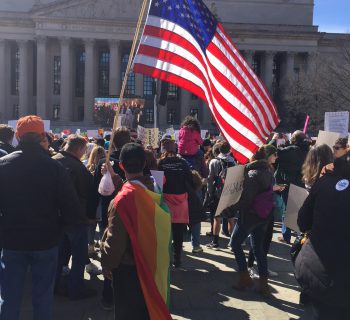Alexia Camm
The Brazilian Amazon has been ablaze for more than 30-days. While worldwide government and military officials strive to extinguish the flames in the region, many environmental scientists and researchers warn that the inferno could bring monumental devastation to the world.
Many small fires occur during the dry season in the Amazon however, the location and the magnitude at which the terrain is currently burning is what experts describe as, abnormal. The smoldering greenery of the rainforest, spreading over 2.1 million square miles, covers nine countries, including much of South America and into French Guiana. The so-called lungs of our world could prove to be in major jeopardy of a sooner demise if not controlled.
A 2014 study in the journal Nature Climate Change found that the potential deforestation of the Amazon could affect rainfall patterns in the United States, and could also threaten the production of food and likely destabilize entire ecosystems. With atmospheric reaches into Africa, South America and the United States of America, the fires are flattening the Amazon. The world is at risk of drying up paramount atmospheric rivers, which aid in the production of rain in various locations around the world, including the U.S.
While there is a copious amount of organic matter to decompose in the region, the complete deforestation of the Amazon could contribute to the loss of the planet. According to Erin C. Young an environmental health and safety engineer in Baltimore County, “the [fires] continuation could release huge amounts of carbon dioxide, methane and sulfur dioxide which could speed up the inevitable.” The release of these gases would not only affect rainfall in South America, but according to the World Wildlife Fund’s senior director for the Amazon in the United States, data shows that the rainfall affects areas of the U.S. responsible for agriculture and livestock.
When asked how the Amazon fires affect the community of Baltimore County, Mr. Young exposed the waste diversion method the home region utilizes. “Instead of incinerating waste, county officials should compost more and also get away from single stream recycling.” Single stream recycling is defined on Baltimore County Government’s website as the process when all recyclables are mixed in the same container for collection.
Erin C. Young confirmed that Baltimore County residents and CCBC students are unable to prevent the spread of the Amazon wildfires; however, much can be done to ensure the longevity of the earth.
The recycling and throwing away of compostable matter such as branches, twigs, vegetable waste, fruit scraps, and coffee grounds could be used to create organic matter to aid in plant growth. This type of composting is easily done at home and on a larger scale at many local institutions and businesses.
Niko Bolden, a mass communications student at CCBC is doing what he can to save the environment. The scholar reuses pasta water in a way to provide nutrients to plants. After boiling pasta noodles, Mr. Bolden drains the water into a pitcher he uses to aid in the production of an at-home garden.
The 2019 Annual Sustainability Report at CCBC states that the college is a sustainable community college. Using the “Sustainability Tip of the Week,” the campus is making efforts to educate students on the concept of holistic sustainability – making their focus on how to dispose of trash properly.
Kayla Jones, a nursing student at CCBC has stopped discarding her eaten fruit in trash bins; instead, she tosses her banana peels in areas of greenery. “Why throw [fruit] away when [it’s] biodegradable and can be used to help our planet.”
This proves that CCBC is achieving the three principles governing their sustainability efforts – education, awareness, and engagement.
Follow this link to learn how compost material is made at home.















I usually do not read a lot of articles, but this one caught my eye. The opening paragraph kept me interested and made me want to keep reading. This article gave me a lot of good information on what is going on and what I should know. I really liked how you related the topic to our students and talked about how others are helping with keeping the Earth clean.
In this article it informs the reader about how the amazon fires affect everyone. The article does mention about how the forest is affected by these fires and it also let’s the reader know about how these fires can lead to the loss of the planet. Not only that but the fires that are happening in the amazon also affects rainfall. As the fires are releasing the gases methane, carbon dioxide, and sulfur dioxide. These gases are being absorbed into the rain. Not only are those gases affecting the rain in the amazon but it is also affecting the rain in other areas as well. Erin C. Young who is an environmental health and safety engineer. Tries to give us insight as to what we should do to prevent this. is instead of incinerating recyclable objects we should try to use single stream recycling.
I think it is good that they are making an issue like this news worthy is because just because something is happening over there does not mean that we are not affected by it. We should be mindful of the habits we practice everyday when we are dealing with the environment. It will definitely help if we start practicing better habits when dealing with the environment even more.
Even though the Amazon fires have been going on for quite some time, people seem to have forgotten about it. It was on the news for a period of time, but besides probably environmental activists and those being directly affected, to everyone else, it feels like it has become irrelevant. That doesn’t change the fact that it is still happening and is still doing the same things it was doing when all the attention was on it. This article is an important reminder for everyone and a great example of those who pay attention and care about what is going on. It also provides useful ways to take action that may not directly change the Amazon situation, but can help protect the environment from the dark path could be going down.
This article does a great job highlighting the fires in the Amazon. As one other comment mentioned, this seems to have dropped out of the mainstream new cycle. I recently was reading an article on the fires raging in Australia, which are of equal concern and also going to have a global impact. I especially like the insight on simple ways to be more green. I am a composting advocate and we keep a small garden in the city. I don’t make a lot of pasta, but will certainly be reusing the pasta water going forward.
It is really sad to see this happening, I’m from Brazil and the way the Brazilian government is dealing with the fires is sad, they are ignoring and pretending nothing is happening while the most important forest of the world is being destroyed. Growing up I always agreed with Brazil being responsible for taking care of the Amazon and now I just wish the world would step up and take control over it.
This is a great article. melting my heart as I was reading. Reading it helped me acquire great information.
What a tragedy!
This article stands for a strong voice that needs to take action to save the environment. Moreover, the article provides awareness which has to septs forward from every sector either could be private, corporate, and governments.
Months later and this article is still concerning, it is tragic to see and also hear what could become of this. Im not a big reader but I am big into saving the only planet we have.
I really appreciate your piece of work, Great post.